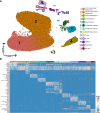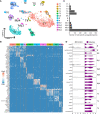Single cell transcriptomics of Atlantic salmon (Salmo salar L.) liver reveals cellular heterogeneity and immunological responses to challenge by Aeromonas salmonicida
- PMID: 36091005
- PMCID: PMC9450062
- DOI: 10.3389/fimmu.2022.984799
Single cell transcriptomics of Atlantic salmon (Salmo salar L.) liver reveals cellular heterogeneity and immunological responses to challenge by Aeromonas salmonicida
Abstract
The liver is a multitasking organ with essential functions for vertebrate health spanning metabolism and immunity. In contrast to mammals, our understanding of liver cellular heterogeneity and its role in regulating immunological status remains poorly defined in fishes. Addressing this knowledge gap, we generated a transcriptomic atlas of 47,432 nuclei isolated from the liver of Atlantic salmon (Salmo salar L.) contrasting control fish with those challenged with a pathogenic strain of Aeromonas salmonicida, a problematic bacterial pathogen in global aquaculture. We identified the major liver cell types and their sub-populations, revealing poor conservation of many hepatic cell marker genes utilized in mammals, while identifying novel heterogeneity within the hepatocyte, lymphoid, and myeloid lineages. This included polyploid hepatocytes, multiple T cell populations including γδ T cells, and candidate populations of monocytes/macrophages and dendritic cells. A dominant hepatocyte population radically remodeled its transcriptome following infection to activate the acute phase response and other defense functions, while repressing routine functions such as metabolism. These defense-specialized hepatocytes showed strong activation of genes controlling protein synthesis and secretion, presumably to support the release of acute phase proteins into circulation. The infection response further involved up-regulation of numerous genes in an immune-cell specific manner, reflecting functions in pathogen recognition and killing, antigen presentation, phagocytosis, regulation of inflammation, B cell differentiation and T cell activation. Overall, this study greatly enhances our understanding of the multifaceted role played by liver immune and non-immune cells in host defense and metabolic remodeling following infection and provides many novel cell-specific marker genes to empower future studies of this organ in fishes.
Keywords: bacterial infection; immune-metabolism cross talk; liver; salmonid fish; single cell transcriptomics.
Copyright © 2022 Taylor, Ruiz Daniels, Dobie, Naseer, Clark, Henderson, Boudinot, Martin and Macqueen.
Conflict of interest statement
The authors declare that the research was conducted in the absence of any commercial or financial relationships that could be construed as a potential conflict of interest.
Figures




Similar articles
-
Cell atlas of the Atlantic salmon spleen reveals immune cell heterogeneity and cell-specific responses to bacterial infection.Fish Shellfish Immunol. 2024 Feb;145:109358. doi: 10.1016/j.fsi.2024.109358. Epub 2024 Jan 3. Fish Shellfish Immunol. 2024. PMID: 38176627
-
Effects of Vitamin D2 (Ergocalciferol) and D3 (Cholecalciferol) on Atlantic Salmon (Salmo salar) Primary Macrophage Immune Response to Aeromonas salmonicida subsp. salmonicida Infection.Front Immunol. 2020 Jan 14;10:3011. doi: 10.3389/fimmu.2019.03011. eCollection 2019. Front Immunol. 2020. PMID: 32010129 Free PMC article.
-
Interacting Effects of Sea Louse (Lepeophtheirus salmonis) Infection and Formalin-Killed Aeromonas salmonicida on Atlantic Salmon Skin Transcriptome.Front Immunol. 2022 Mar 24;13:804987. doi: 10.3389/fimmu.2022.804987. eCollection 2022. Front Immunol. 2022. PMID: 35401509 Free PMC article.
-
Cooperation of liver cells in health and disease.Adv Anat Embryol Cell Biol. 2001;161:III-XIII, 1-151. doi: 10.1007/978-3-642-56553-3. Adv Anat Embryol Cell Biol. 2001. PMID: 11729749 Review.
-
Liver in infections: a single-cell and spatial transcriptomics perspective.J Biomed Sci. 2023 Jul 10;30(1):53. doi: 10.1186/s12929-023-00945-z. J Biomed Sci. 2023. PMID: 37430371 Free PMC article. Review.
Cited by
-
Single-cell transcriptomic dynamics of scallop heart reveals the heterogeneous response to heat stress.BMC Biol. 2025 Apr 15;23(1):98. doi: 10.1186/s12915-025-02210-1. BMC Biol. 2025. PMID: 40234911 Free PMC article.
-
Season affects the estrogen system and the immune response of common carp.Fish Physiol Biochem. 2024 Apr;50(2):797-812. doi: 10.1007/s10695-023-01286-2. Epub 2023 Dec 29. Fish Physiol Biochem. 2024. PMID: 38157099 Free PMC article.
-
A versatile nuclei extraction protocol for single nucleus sequencing in non-model species-Optimization in various Atlantic salmon tissues.PLoS One. 2023 Sep 7;18(9):e0285020. doi: 10.1371/journal.pone.0285020. eCollection 2023. PLoS One. 2023. PMID: 37676875 Free PMC article.
-
Single-cell atlas of rainbow trout peripheral blood leukocytes and profiling of their early response to infectious pancreatic necrosis virus.Front Immunol. 2024 Jul 5;15:1404209. doi: 10.3389/fimmu.2024.1404209. eCollection 2024. Front Immunol. 2024. PMID: 39035000 Free PMC article.
-
Catching the Big Fish in Big Data: A Meta-Analysis of Zebrafish Kidney scRNA-Seq Datasets Highlights Conserved Molecular Profiles of Macrophages and Neutrophils in Vertebrates.Biology (Basel). 2024 Sep 27;13(10):773. doi: 10.3390/biology13100773. Biology (Basel). 2024. PMID: 39452082 Free PMC article.
References
Publication types
MeSH terms
Substances
LinkOut - more resources
Full Text Sources
Miscellaneous

